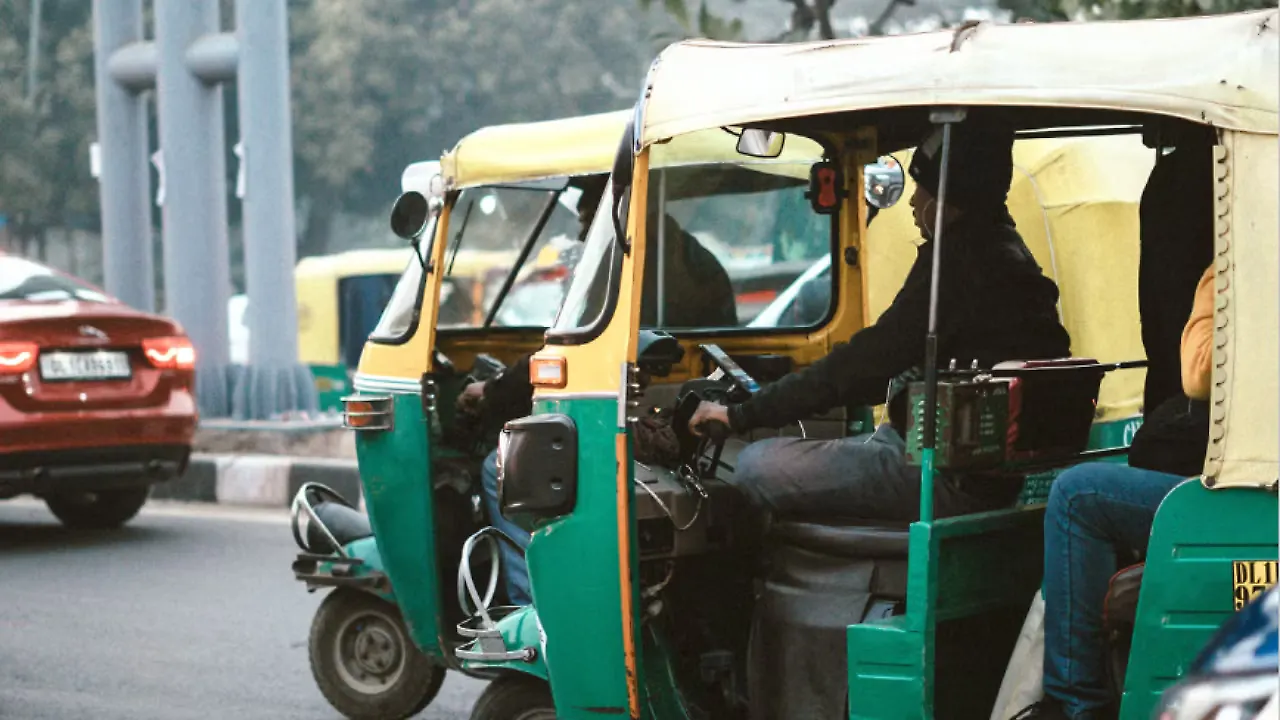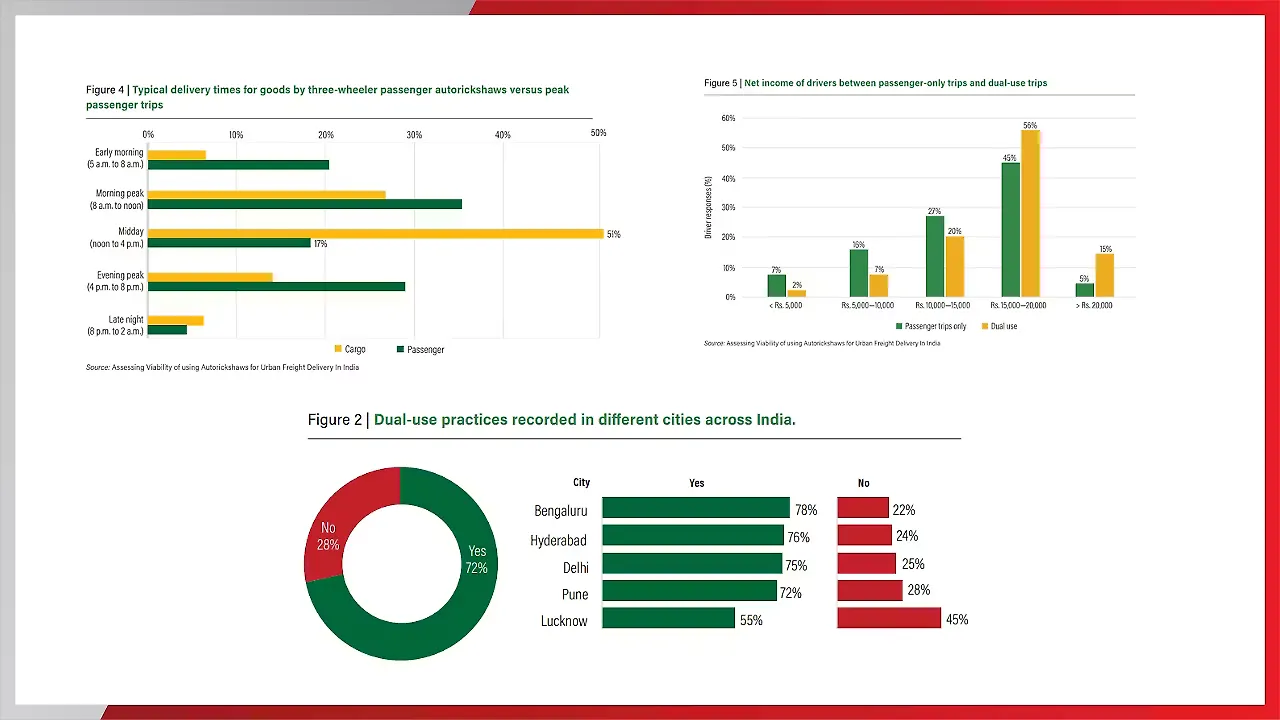
In this day and age of digitalisation, online shopping has become a necessity for most people and with this, there is an immense rise in the number of e-commerce websites. Alongside traditional commerce, enterprises, too, are relying on doorstep deliveries to maintain their charm. With this increase, the need for last-mile delivery is at an all-time high.
The working paper launched in the presence of Dr O P Agarwal, Senior Advisor, WRI India, at the India Habitat Centre states that in 2021, eight million commercial deliveries were carried out daily in India’s urban areas.
Although e-commerce transport is increasing, traditional commerce enterprises dominate urban demand. Informal operators still provide most traditional deliveries of perishable goods, such as fruits and vegetables and other groceries, as well as bulk commodities like construction materials, the WRI India report said.
Niti Ayog suggests that between 2020 and 2030, India’s freight activity will increase five-fold, while GLG Insights 2021 stated that daily commercial deliveries in India are expected to grow 40% annually by 2025.
The WRI report continued that to meet the demand, India needs to explore new forms of micro-mobility-based, last-mile freight modes, focusing on low-emissions cargo transportation and optimising existing vehicle stocks.
While India has quite a few options for last-mile delivery, currently, there is no vehicle category for transporting goods between 30 kg and 350 kg. The WRI India paper looks at the current Indian urban freight ecosystem and examines the market gap that the dual utilisation of autorickshaws can fill.
Currently, most of the e-commerce deliveries happen on two-wheelers. The report mentions that while two-wheelers are agile, they are unsuitable for carrying heavy freight. Meanwhile, three and four-wheeled cargo vehicles, with a carrying capacity of 400 kg to 700 kg, end up getting underutilised as they are used to carry smaller payloads.
This is where three-wheelers can play a significant role.
WRI says 3Ws fare better than other micro-mobility modes in carrying heavier freight, as they have the flexibility and manoeuvrability of a two-wheeler that enables navigating crowded narrow streets and are designed to carry payloads of up to 300 kg.
An auto rickshaw's dual role would also help reduce carbon emissions, WRI noted. India’s transport sector has the fastest-growing emissions of any sector and is responsible for 13.5% of total energy-related carbon dioxide (CO2) emissions.
Assuming the average single trip length to be 15 km, a three-wheeler CNG autorickshaw which made up 64% of total autorickshaws registered in 2022, loaded at 250 kg, would emit 4.66 g of CO2 emissions per km/kg of goods carried as compared to a partially loaded 3-wheeler cargo which will emit 7.90 g of CO2 emissions per km/kg of goods carried for the same trip.
Pranav Goel, Chief Executive Officer, Porter, believes that India can save $3 billion annually by optimising urban freight, which aligns with the overarching vision of the National Logistics Policy of optimising and reducing the current logistics cost in the country. In addition, optimising the usage of vehicles like three-wheeler autorickshaws, which are 50% emission efficient as compared to three/four-wheeler cargo vehicles, will enable the shift to low-carbon pathways - a critical element in helping India achieve the net zero target for 2070.
Dual Income
One must remember, at the end of the day, an autorickshaw is a source of income for the driver. So more than carbon neutrality, it is the RoI that the driver will be interested in. The paper titled ‘Assessing the Viability of Using Autorickshaws for Urban Freight Delivery in India’, indicates that dual utilisation of autorickshaws can not only overcome supply gaps in the freight ecosystem but can also provide an additional source of income to autorickshaw drivers.
Most drivers drive approximately 100–120 km/day and report earnings of an average of INR 7,000 to INR 9,000 per month. After fuel and maintenance costs, the drivers’ incomes can barely support their families. Furthermore, the current fare system does not account for potential forgone income resulting from time lost during off-peak hours or between fares – time that could be used for other purposes, such as transporting goods.
WRI India conducted primary surveys in five cities — Bengaluru, Delhi, Hyderabad, Lucknow and Pune — with business owners, retailers, dealers, distributors and drivers, among others, with a sample size of 1,388 respondents. The key question posed to autorickshaw drivers was, “Do you make dual-use trips, that is, both passenger and goods trips, on a working day?”
The analysis suggests that dual utilisation of autorickshaws can increase driver income by 15% and reduce the cost of logistics for Micro, Small & Medium Enterprises (MSMEs). About 72% of respondents said they already make dual trips. This held true across regions, with nearly three-quarters of respondents adopting dual utility in Bengaluru, Hyderabad and Delhi. The research also indicates that the optimum utilisation of passenger autorickshaws for freight could potentially reduce CO2 emissions by 51.5% on every trip.

However, in Lucknow, the share was relatively lower at 55%. Potential reasons could be the predominance of other affordable micro-mobility options, like the ubiquitous hand-drawn carts and cycles used for transporting goods over short distances.
Nonetheless, it was found that the versatility of autorickshaws on Indian roads, their lower environmental impact compared to un-optimised cargo vehicles, their complementarity with passenger trips, and their potential to generate higher income, make them a viable option for dual use.
The survey indicates that dual utility can increase both the utilisation of autorickshaws and their utilisation value per unit, as each vehicle would spend less time idle. The survey asked respondents already transporting small consignments of cargo whether this practice is beneficial to them.
About 60% of these drivers felt it benefited them, with around 40% stating that it brought them more income. Subsequent analysis of drivers’ net income — their earnings after fuel expenses, rent, and maintenance—revealed that drivers making dual trips earned around 15% more than drivers who only made passenger trips. Other analysis, based on limited surveys, suggests that dual use of autorickshaws could increase drivers’ earnings by as much as 60%.
Conclusion
To regulate the dual use of autorickshaws, WRI, in its research paper, puts forth a few key points. First, WRI suggests that an expert committee/working group must be set up to formulate and define necessary safety standards and suggest regulatory interventions for the dual use of passenger autorickshaws.
While current data shows autorickshaws are less prone to toppling, cargo distribution in the vehicle is critical while undertaking dual use, and this heavily depends on how the commodities are loaded. Therefore, capacity-building exercises that provide clear instructions to drivers must be offered as part of a holistic regulation. Drivers must understand how to drive safely when fully loaded and stack cargo properly.
Moreover, new sets of regulations also need to come in to support such acts. Typically, three-wheeler cargo vehicles operate under goods carriage permits, and three-wheeler passenger autorickshaws hold contract carriage permits. To enable hybrid use, states would need to consider allowing passenger autorickshaws to operate under the provisions of both permits.
N Mohan, CEO, Delhi EV Cell, says that allowing passenger autorickshaws for goods transport requires regulations under the Central Motor Vehicles Rules.
There is a precedent for regulatory changes in the case of two-wheelers allowed for dual use and enabling provisions in the form of 2019 amendments to the Motor Vehicles Act of 1988, particularly in Sections 2B, 66A, and 67, to improve logistics efficiency in the last mile, promote social equity, and enhance upward income mobility for millions of drivers working in this ecosystem.
Autorickshaws’ versatility on Indian roads, their lower environmental impact compared to underutilised cargo vehicles, their complementarity with passenger trips, and their potential to generate a higher income make them a viable proposition for dual use.
However, the transition would require careful consideration, and this working paper has laid the groundwork to enhance awareness of the concept of dual use of three-wheeler autorickshaws for urban freight operations and provided initial solutions for its successful implementation, WRI said.
Rohan Rao, Program Manager, Electric Mobility, WRI India and the lead author of the paper, concludes by stating that this working paper lays the groundwork to enhance awareness on the concept of dual use of three-wheeler autorickshaws for urban freight operations and provides initial solutions for its implementation. However, there is room for further study, especially regarding safety parameters, autorickshaws' design, and other micro-mobility options to facilitate goods transportation.
Also Read
Global Electric 3-Wheeler Market To Grow At 6.5% CAGR Till 2027